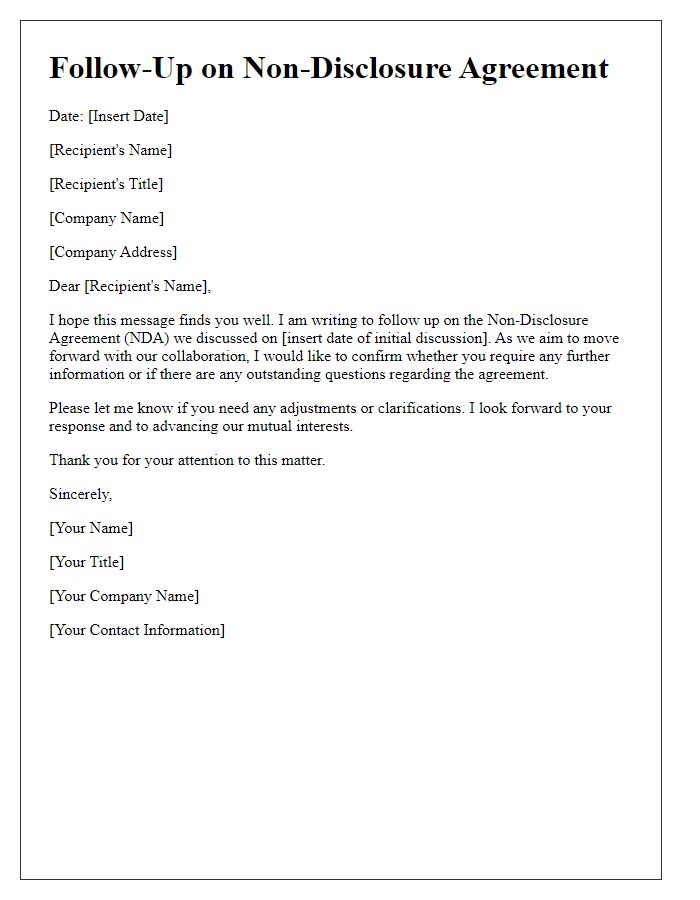In today's fast-paced business world, confidentiality is more important than ever, and having a solid confidentiality clause in place is crucial for protecting sensitive information. This letter template will help you enforce these important agreements, ensuring that all parties understand their responsibilities. With clear language and a straightforward approach, you can address potential breaches effectively. Ready to dive into the specifics of drafting an enforceable confidentiality clause? Let's explore!

Clear identification of parties involved
The confidentiality clause enforcement outlines critical protections for sensitive information shared between parties. The primary entities, such as Company A (e.g., a technology firm based in Silicon Valley) and Company B (e.g., a research institution located in Cambridge), must be clearly identified. Each party engages in a binding agreement to uphold confidentiality obligations pertaining to proprietary data, trade secrets, and intellectual property. Defined roles, such as "Disclosing Party" for Company A and "Receiving Party" for Company B, emphasize the expectations of information handling and disclosure limits. Both parties must acknowledge the potential consequences of unauthorized information sharing, which can lead to legal action, loss of competitive advantage, and significant financial penalties.
Detailed description of confidential information
Confidential information encompasses any data or knowledge that is proprietary and not publicly available, including trade secrets, client lists, financial statements, product designs, and marketing strategies. This information can include technical specifications for a new product, like those developed by tech firms in Silicon Valley, which often involves intricate details about software algorithms and hardware components. Other sensitive data may include proprietary formulas or recipes held by pharmaceutical companies and food manufacturers, valued for their economic significance. Confidential agreements may also protect customer data and personally identifiable information (PII), crucial for compliance with regulations such as GDPR in Europe or CCPA in California. Ensuring confidentiality involves strict adherence to security protocols, including restricted access to files, encryption of electronic communications, and comprehensive employee training on privacy policies. Breaches of confidentiality may lead to significant legal repercussions and financial losses, thus underlining the importance of rigorous enforcement of confidentiality clauses in business contracts.
Specific terms of confidentiality violation
Confidentiality clauses serve to protect sensitive information in various contexts, such as business contracts and employee agreements. Violations of confidentiality can occur when proprietary information, trade secrets, or client details are disclosed without authorization. Specific terms of violation may involve unauthorized sharing of documents, electronic communications, or verbal discussions. Consequences for breaches can include legal action, financial penalties, and injunctions to prevent further disclosure. These breaches not only jeopardize competitive advantage but also damage relationships with clients and stakeholders, emphasizing the importance of strict adherence to confidentiality agreements.
Consequences and remedies for breach
Confidentiality agreements protect sensitive information from unauthorized disclosure. Breaches can lead to serious consequences such as legal action, financial penalties, or damage to reputation. Remedies may include injunctions to prevent further breaches, monetary compensation for damages incurred, or specific performance to enforce the agreement. In jurisdictions like California, the Uniform Trade Secrets Act may apply, providing additional legal frameworks for protection. Ensuring all parties understand the importance of confidentiality can help mitigate risks associated with information disclosure.
Legal jurisdiction and governing law
Legal documents, particularly confidentiality agreements, must establish clear legal jurisdiction and governing law to ensure enforceability. Jurisdiction, often defined by geographic location such as pertinent states or countries (e.g., California, USA), determines which court has authority to resolve disputes. Governing law specifies the legal framework (e.g., California Civil Code) that will interpret the terms of the contract. These elements are crucial for safeguarding proprietary information and ensuring that both parties agree to a standardized set of legal principles, promoting clarity in enforcement mechanisms. Furthermore, the choice of jurisdiction can influence the speed and cost of legal proceedings significantly.













Comments